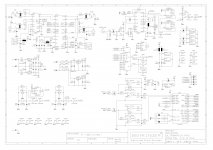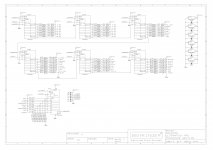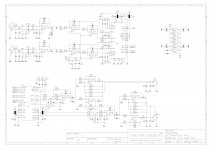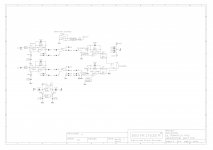Just got a reply from miniDSP on "can the USBStreamer be set to operate as I2S slave"
On the USBStreamer, it's really what the user manual says. 🙂 No, it doesn't operate as I2S slave (would be impossible to follow the rate of the song, that is ALWAYS carried over asynchronous USB). Unless if we had a sample rate converter, USB devices are really meant to be master (and that's what we're using asynchronous transfer).
The USB transfer has nothing to do with I2S. USB is double buffered and so are the I2S ports.
Besides it not a SRC that's needed it's asynchronous pingpong buffer aka fifo. But this would shove the cost up. So I guess it's DIY. Jens has a working solution.
On the USBStreamer, it's really what the user manual says. 🙂 No, it doesn't operate as I2S slave (would be impossible to follow the rate of the song, that is ALWAYS carried over asynchronous USB). Unless if we had a sample rate converter, USB devices are really meant to be master (and that's what we're using asynchronous transfer).
The USB transfer has nothing to do with I2S. USB is double buffered and so are the I2S ports.
Besides it not a SRC that's needed it's asynchronous pingpong buffer aka fifo. But this would shove the cost up. So I guess it's DIY. Jens has a working solution.
OK, I give up. This is all too confusing. I bought a QA400. I'll just have to live with it's limitations.
OK, I give up. This is all too confusing. I bought a QA400. I'll just have to live with it's limitations.
What's to be confused about. The QA400 is a great analyzer for the money. We're just toying around with this other stuff.
I should start an off topic thread for all the forks in these threads. Then when anything comes up we just move the discussion.
I think this is a real example of the cost of a small improvement. QA400; $200 and its works quite well for what it does. Premium sound card and software; $150 to $1200 for the hardware and $25 to $1500 for software. Possibly a 10 dB improvement and still pretty clumsy to use. PC based digital instrument e.g. Prizm or AP $5k to $12K; maybe another 2-3 dB of improvement. AP2722, R&S UPV or Shibasoku 725 $25K and a further improvement of maybe 6-10dB max. How many power amps are better than the QA400 can measure? How many preamps?
My interest in this came from verifying ADC's and test oscillators, something in a little corner by itself. Otherwise its a very academic pursuit, even though I have learned a lot about how to make a better circuit in the process.
My interest in this came from verifying ADC's and test oscillators, something in a little corner by itself. Otherwise its a very academic pursuit, even though I have learned a lot about how to make a better circuit in the process.
I think this is a real example of the cost of a small improvement. QA400; $200 and its works quite well for what it does. Premium sound card and software; $150 to $1200 for the hardware and $25 to $1500 for software. Possibly a 10 dB improvement and still pretty clumsy to use. PC based digital instrument e.g. Prizm or AP $5k to $12K; maybe another 2-3 dB of improvement. AP2722, R&S UPV or Shibasoku 725 $25K and a further improvement of maybe 6-10dB max. How many power amps are better than the QA400 can measure? How many preamps?
My interest in this came from verifying ADC's and test oscillators, something in a little corner by itself. Otherwise its a very academic pursuit, even though I have learned a lot about how to make a better circuit in the process.
And if we can get that 10dB without breaking the bank or entering the above mentioned arena then wow. Also much satisfaction along the way.
I think this is a real example of the cost of a small improvement. QA400; $200 and its works quite well for what it does. Premium sound card and software; $150 to $1200 for the hardware and $25 to $1500 for software. Possibly a 10 dB improvement and still pretty clumsy to use. PC based digital instrument e.g. Prism or AP $5k to $12K; maybe another 2-3 dB of improvement. AP SYS-2722, R&S UPV or Shibasoku 725 $25K and a further improvement of maybe 6-10 dB max.
True--the last dB is always the most expensive one! The pro equipment you mention of course has way more features than the QA400, so comparing simply based on THD/THD+N performance is not entirely fair.
I have sketched an interface for the QA400 (or other soundcard approaches) which should considerably improve its performance (low-pass filtering the DAC, notching before the ADC side) and not cost too much. Just no time to do any practical work in the near future...
Samuel
PS: Short jitter story--the last few days I've been working on an application issue where one of our DACs didn't sync with a network player designed by another company. It turned out that the AES-EBU/SPDIF output of the network player had an unusually high low-frequency jitter spectrum. With a 85 mHz high-pass filtered jitter measurement, the peak-to-peak jitter was near 1 us (micro!). Viewed on a scope, the poor bits drifted around like a drunken sailor! The interface still easily met AES standards, as the high-pass filter specified in the standard is way higher than 85 mHz (70 Hz IIRC), and removed the significant low-frequency jitter.
What's to be confused about. The QA400 is a great analyzer for the money. We're just toying around with this other stuff.
I should start an off topic thread for all the forks in these threads. Then when anything comes up we just move the discussion.
Well, because you all said a lot of bad things about the QA400, and then started looking for alternatives, and virtually ALL of the alternatives you were talking about are No Longer Available. So, for someone like me trying to make a decision about what to get, I was extremely confused because I don't want to buy used gear. Is that more clear now?
I mean, how long have I waited on the other threads for someone to come up with a nice ADC board? IT's like forever. back and forth, blah blah blah.... jeez!
So, I give up. The QA400 will have to be good enough.
It will still take a while before it is finished, but I am trying to put an AK5394A + AK4399 design together. I already have some inputs/feature requests from Demian.
Once I get some results from that I will open a new thread with a description of the design. Initially I am focusing on the basic converter part. The design of that is close to being finished. Later I plan to add a good analog front end.
Jens
Once I get some results from that I will open a new thread with a description of the design. Initially I am focusing on the basic converter part. The design of that is close to being finished. Later I plan to add a good analog front end.
Jens
It will still take a while before it is finished, but I am trying to put an AK5394A + AK4399 design together. I already have some inputs/feature requests from Demian.
Once I get some results from that I will open a new thread with a description of the design. Initially I am focusing on the basic converter part. The design of that is close to being finished. Later I plan to add a good analog front end.
Jens
Well that's great! I hope it turns out well for you.
OK, I give up. This is all too confusing. I bought a QA400. I'll just have to live with it's limitations.
Me too! : D
True--the last dB is always the most expensive one! The pro equipment you mention of course has way more features than the QA400, so comparing simply based on THD/THD+N performance is not entirely fair.
I have sketched an interface for the QA400 (or other soundcard approaches) which should considerably improve its performance (low-pass filtering the DAC, notching before the ADC side) and not cost too much. Just no time to do any practical work in the near future...
Samuel
PS: Short jitter story--the last few days I've been working on an application issue where one of our DACs didn't sync with a network player designed by another company. It turned out that the AES-EBU/SPDIF output of the network player had an unusually high low-frequency jitter spectrum. With a 85 mHz high-pass filtered jitter measurement, the peak-to-peak jitter was near 1 us (micro!). Viewed on a scope, the poor bits drifted around like a drunken sailor! The interface still easily met AES standards, as the high-pass filter specified in the standard is way higher than 85 mHz (70 Hz IIRC), and removed the significant low-frequency jitter.
Isn't your DAC supposed to follow the nice vibrato enhancement from the source device? I;'m sure someone will find your DAC lifeless without that vibrato.
I would think it very difficult to make the clocks do that unless the power supplies for the crystal oscillators are in serious trouble. Or there are some poorly implemented PLL's.
I would like to see the block diagram of your proposal for an interface. I may be able to patch some of those ideas into what I'm working on.
Does the Behringer Ultra Match Pro (model SRC2496) make a good starter basis for this and other things? Wonder which chips it uses. ??
THx-RNMarsh
THx-RNMarsh
Well, because you all said a lot of bad things about the QA400, and then started looking for alternatives, and virtually ALL of the alternatives you were talking about are No Longer Available. So, for someone like me trying to make a decision about what to get, I was extremely confused because I don't want to buy used gear. Is that more clear now?
I mean, how long have I waited on the other threads for someone to come up with a nice ADC board? IT's like forever. back and forth, blah blah blah.... jeez!
So, I give up. The QA400 will have to be good enough.
The QA400 had its teething issues.... I had to buy another portable computer to have a USB port that is usable with it. And, software scaling on the GUI display wasnt right. I thought it was the QA400... bought a second one and same, same with it. Finally, I get it working and find that it is pretty good down to -100dB and below that it isnt accurate. But that is the same with most of them so far that I checked. But a notch filter will get you below the -100dB mark accurately.
I want accuracy to as low as is humanly possible and for a few hundred dollars we got pretty close to $$$ commercial gear.... though the commercial gear can do a lot of other tests. So, I went on with ShibaSoku and newer Audio-Precision. I am just now recovering from that financial shock. Now I can compare data from QA400 with the SOTA commercial gear. But, I tried real hard, first modifying other older commercial gear (K-H, HP etc). That stuff also can get you to -100dB distortion or lower with a lot more effort.
The QA400 produces a lot of Bang for your money. You'll be fine with it.... just note the limits and not be fooled into believing everything it tells you below -100dB.
There is now the potential to do better with the AK chips and still have low cost. That is where this story has taken us.
THx-RNMarsh
Last edited:
It will still take a while before it is finished, but I am trying to put an AK5394A + AK4399 design together. I already have some inputs/feature requests from Demian.
Jens
Well, I may have some more 😀 ... may use the PM channel to communicate

Hp
Well, I may have some more 😀 ... may use the PM channel to communicate
Hp
That would be great. 🙂
It could also be useful to have some SW control of the analog front-end, to avoid having to compensate levels due to manual attenuator and gain settings, which are otherwise unknown to the PC SW. I assume that is an area where you could help.😎
I would think it very difficult to make the clocks do that unless the power supplies for the crystal oscillators are in serious trouble. Or there are some poorly implemented PLLs.
I'm too wondering what caused so much drift. It looks like there is a PLL working that has a reasonably good local VCO (peak-to-peak jitter above a some 10 Hz is below 1 ns) but follows a very jittery source.
I would like to see the block diagram of your proposal for an interface. I may be able to patch some of those ideas into what I'm working on.
I'll try to do what time allows.
Samuel
LOL, I paid for a mint condition NOS one on eBay just this morning, I should have it in a few days.Does the Behringer Ultra Match Pro (model SRC2496) make a good starter basis for this and other things? Wonder which chips it uses. ??
THx-RNMarsh
I wonder the same, so I decided to give one a try.
ADC is AKM5393, and DAC is AKM4393.
I have found discussion on the net of the usual Behringer 'ímprovements', but so far no real measurements.
I have an Edirol UA-25ex usb soundcard with spdif in/out.
Hopefully with the Edirol, the SRC2496 effectively becomes a usb soundcard, better than the Edirol.
The Edirol ADC kicks up truckloads of harmonics at input levels greater than about -6dBfs.
So, in combination with AWA F242 D&N set used as auto nulling notch filter, maybe I end up with pretty good loopback testing with any T&M software, unlike the QA400.
The SRC has a front panel stereo input level control.....total pita.
That might get replaced with stepped attenuators or 10-turn trimmers for accuracy, stability and set-ability.
http://www.lampizator.eu/LAMPIZATOR/TRANSPORT/behringer/SRC2496.pdf




View attachment SRC2496.zip
Mods/improvements suggestions are welcome.
Dan.
Last edited:
Just got my PCB from OSHPark this week. Part way through assembling one of them I discovered there is no plating on any of the pad holes or vias. This is a double sided board and quite useless without plated holes.
Anyone seen this before.
Anyone seen this before.
Just got my PCB from OSHPark this week. Part way through assembling one of them I discovered there is no plating on any of the pad holes or vias. This is a double sided board and quite useless without plated holes.
Anyone seen this before.
Maybe you can send them back and ask to plate the holes... if a mistake... no cost to you.... if they said you didnt ask for plated thru holes... its a few coins extra. Thats what i would do.
-RNM
- Home
- Design & Build
- Equipment & Tools
- QuantAsylum QA400 and QA401